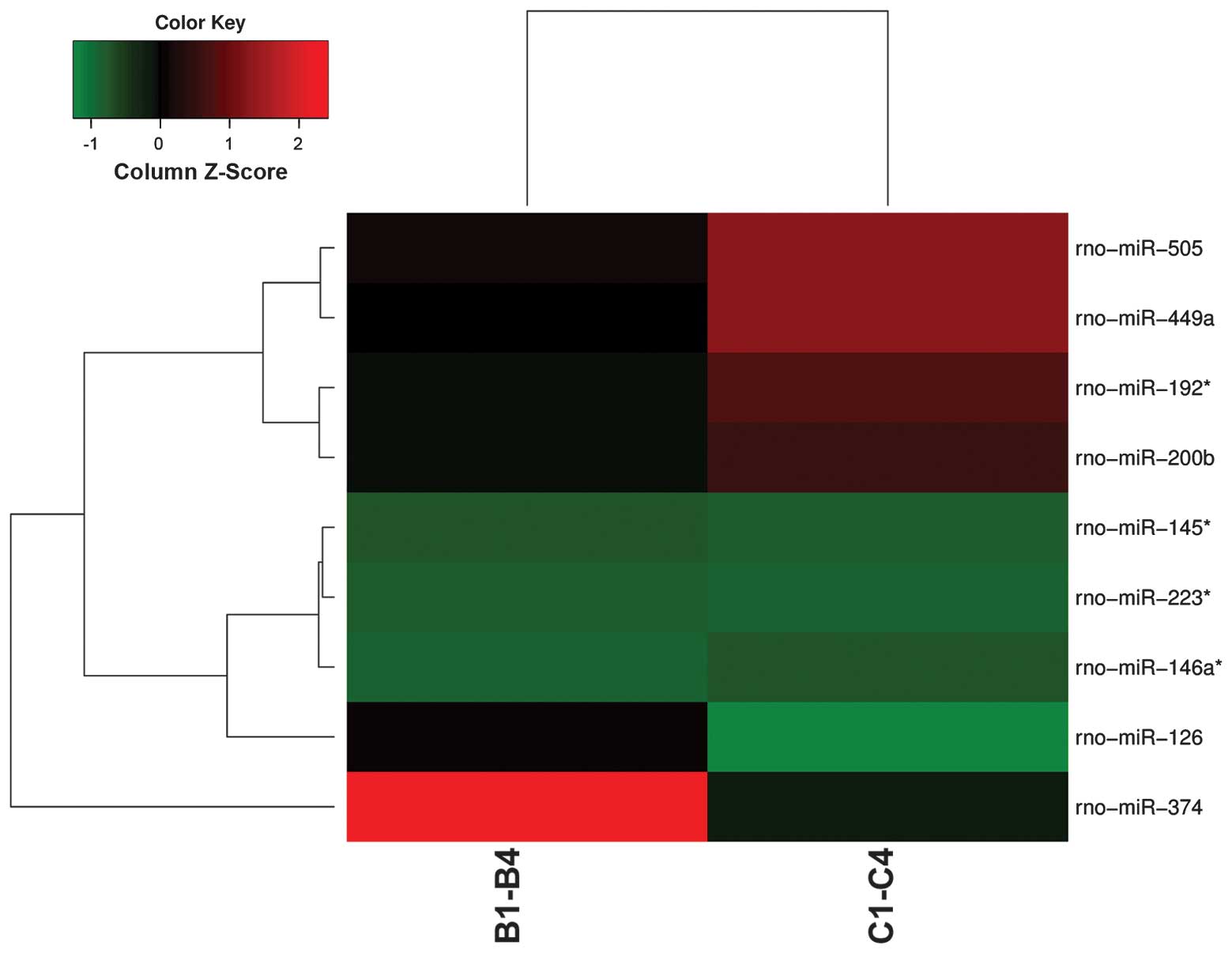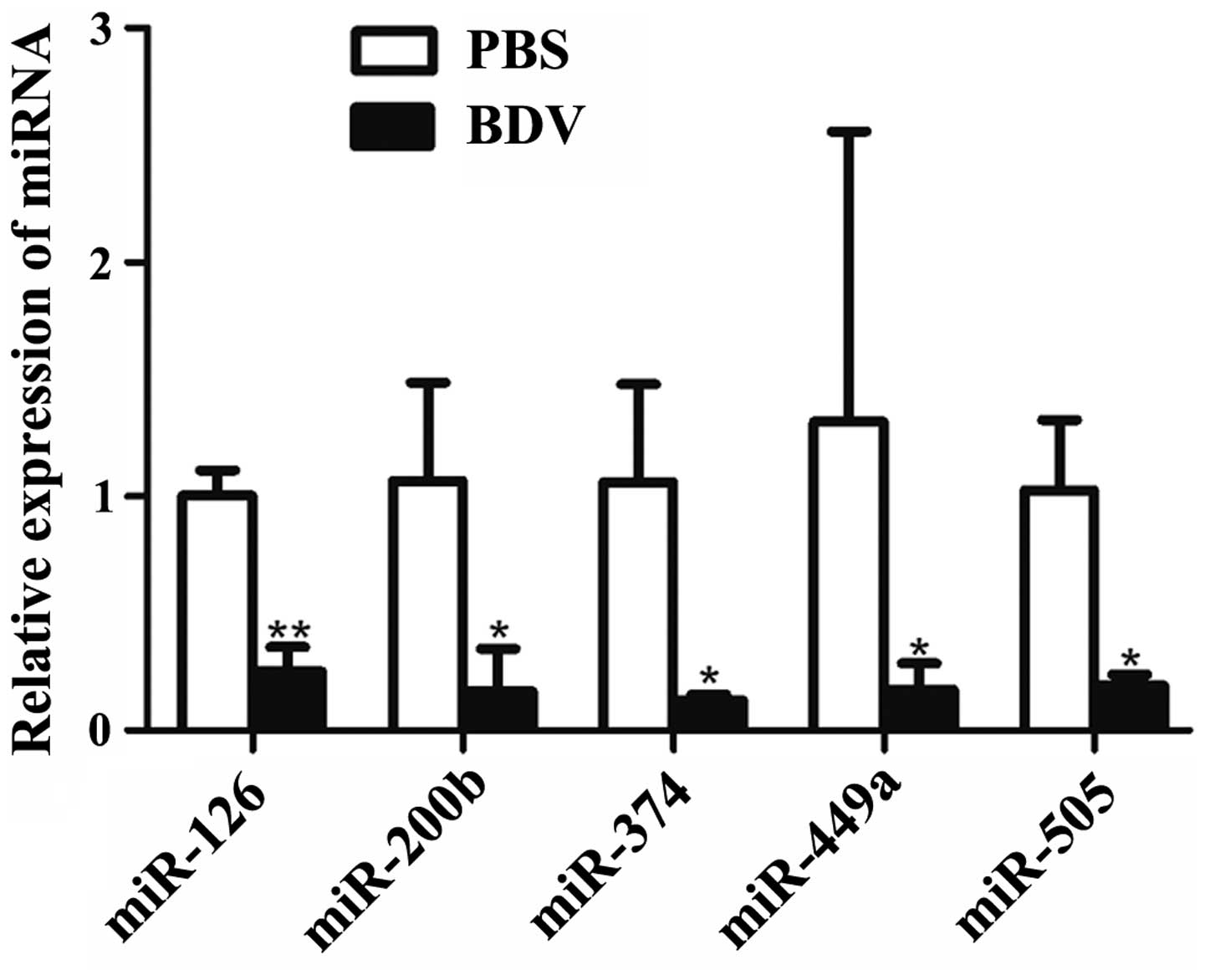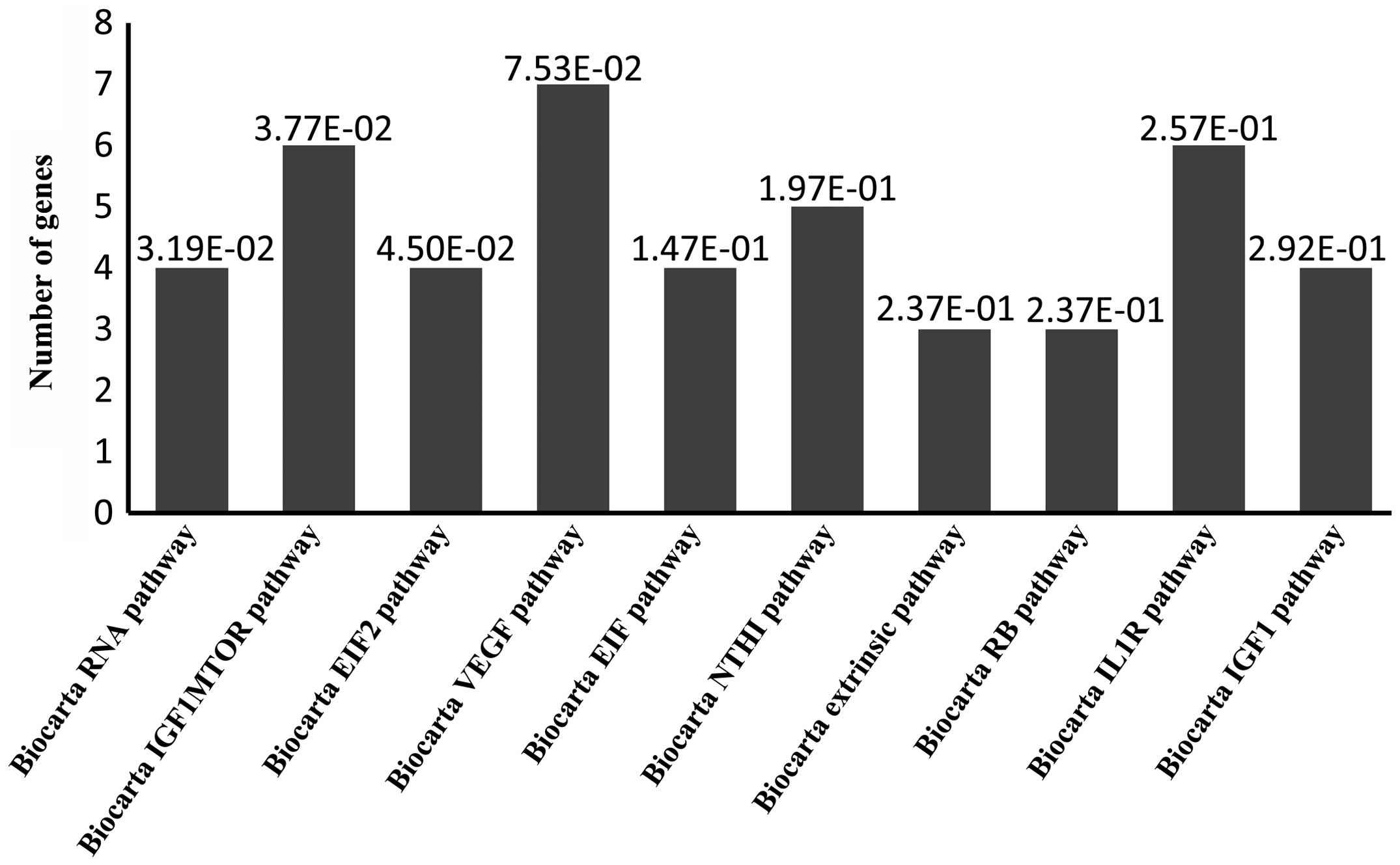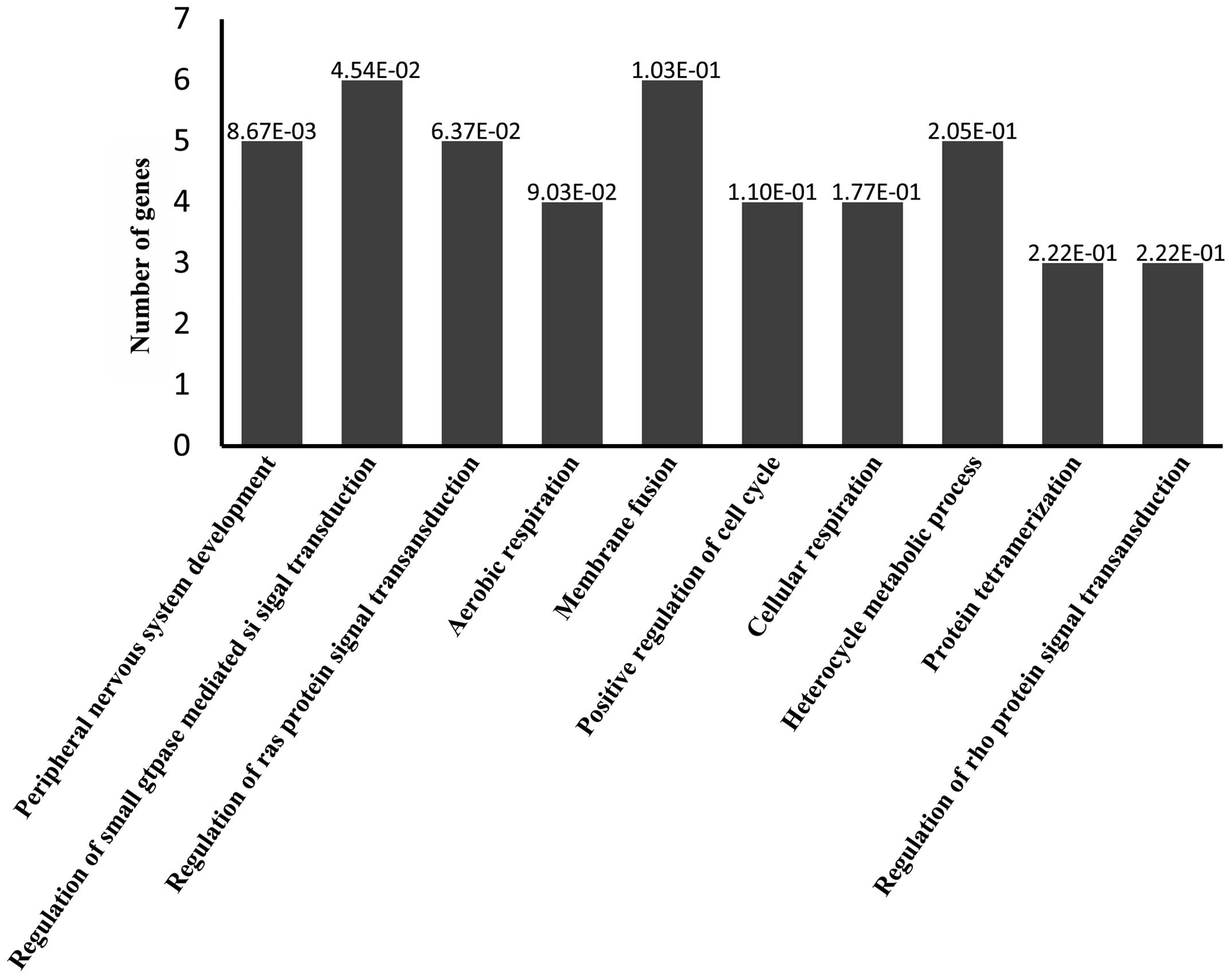|
1
|
Zhang L, Wang X, Zhan Q, et al: Evidence
for natural Borna disease virus infection in healthy domestic
animals in three areas of western China. Arch Virol. 159:1941–1949.
2014. View Article : Google Scholar : PubMed/NCBI
|
|
2
|
Briese T, Schneemann A, Lewis AJ, et al:
Genomic organization of Borna disease virus. Proc Natl Acad Sci
USA. 91:4362–4366. 1994. View Article : Google Scholar : PubMed/NCBI
|
|
3
|
Horie M, Honda T, Suzuki Y, et al:
Endogenous non-retroviral RNA virus elements in mammalian genomes.
Nature. 463:84–87. 2010. View Article : Google Scholar : PubMed/NCBI
|
|
4
|
Bode L and Ludwig H: Borna disease virus
infection, a human mental-health risk. Clin Microbiol Rev.
16:534–545. 2003. View Article : Google Scholar : PubMed/NCBI
|
|
5
|
Amsterdam JD, Winokur A, Dyson W, et al:
Borna disease virus: a possible etiologic factor in human affective
disorders? Arch Gen Psychiatry. 42:1093–1096. 1985. View Article : Google Scholar : PubMed/NCBI
|
|
6
|
Rott R, Herzog S, Fleischer B, et al:
Detection of serum antibodies to Borna disease virus in patients
with psychiatric disorders. Science. 228:755–756. 1985. View Article : Google Scholar : PubMed/NCBI
|
|
7
|
Carbone KM: Borna disease virus and human
disease. Clin Microbiol Rev. 14:513–527. 2001. View Article : Google Scholar : PubMed/NCBI
|
|
8
|
Ikuta K, Ibrahim MS, Kobayashi T and
Tomonaga K: Borna disease virus and infection in humans. Front
Biosci. 7:d470–d495. 2002. View
Article : Google Scholar : PubMed/NCBI
|
|
9
|
Schwemmle M: Borna disease virus infection
in psychiatric patients: are we on the right track? Lancet Infect
Dis. 1:46–52. 2001. View Article : Google Scholar
|
|
10
|
Li Q, Wang Z, Zhu D, et al: Detection and
analysis of Borna disease virus in Chinese patients with
neurological disorders. Eur J Neurol. 16:399–403. 2009. View Article : Google Scholar : PubMed/NCBI
|
|
11
|
Zhang L, Xu MM, Zeng L, et al: Evidence
for Borna disease virus infection in neuropsychiatric patients in
three western China provinces. Eur J Clin Microbiol Infect Dis.
33:621–627. 2014. View Article : Google Scholar
|
|
12
|
Bartel DP: MicroRNAs: target recognition
and regulatory functions. Cell. 136:215–233. 2009. View Article : Google Scholar : PubMed/NCBI
|
|
13
|
Bushati N and Cohen SM: microRNA
functions. Annu Rev Cell Dev Biol. 23:175–205. 2007. View Article : Google Scholar : PubMed/NCBI
|
|
14
|
Ghosh Z, Mallick B and Chakrabarti J:
Cellular versus viral microRNAs in host-virus interaction. Nucleic
Acids Res. 37:1035–1048. 2009. View Article : Google Scholar :
|
|
15
|
Gottwein E and Cullen BR: Viral and
cellular microRNAs as determinants of viral pathogenesis and
immunity. Cell Host Microbe. 3:375–387. 2008. View Article : Google Scholar : PubMed/NCBI
|
|
16
|
Qian J, Zhai A, Kao W, et al: Modulation
of miR-122 on persistently Borna disease virus infected human
oligodendroglial cells. Antiviral Res. 87:249–256. 2010. View Article : Google Scholar : PubMed/NCBI
|
|
17
|
Zhai A, Qian J, Kao W, et al: Borna
disease virus encoded phos-phoprotein inhibits host innate immunity
by regulating miR-155. Antiviral Res. 98:66–75. 2013. View Article : Google Scholar : PubMed/NCBI
|
|
18
|
Hornig M, Weissenböck H, Horscroft N and
Lipkin WI: An infection-based model of neurodevelopmental damage.
Proc Natl Acad Sci USA. 96:12102–12107. 1999. View Article : Google Scholar : PubMed/NCBI
|
|
19
|
Pletnikov MV, Rubin SA, Schwartz GJ, Moran
TH, Sobotka TJ and Carbone KM: Persistent neonatal Borna disease
virus (BDV) infection of the brain causes chronic emotional
abnormalities in adult rats. Physiol Behav. 66:823–831. 1999.
View Article : Google Scholar : PubMed/NCBI
|
|
20
|
Wu YJ, Schulz H, Lin CC, et al: Borna
disease virus-induced neuronal degeneration dependent on host
genetic background and prevented by soluble factors. Proc Natl Acad
Sci USA. 110:1899–1904. 2013. View Article : Google Scholar : PubMed/NCBI
|
|
21
|
Ludwig H and Bode L: Borna disease virus:
new aspects on infection, disease, diagnosis and epidemiology. Rev
Sci Tech Off Int Epiz. 19:259–288. 2000.
|
|
22
|
Clark JD, Gebhart GF, Gonder JC, Keeling
ME and Kohn DF: Special report: the 1996 guide for the care and use
of laboratory animals. ILAR J. 38:41–48. 1997. View Article : Google Scholar : PubMed/NCBI
|
|
23
|
Huang R, Gao H, Zhang L, et al: Borna
disease virus infection perturbs energy metabolites and amino acids
in cultured human oligodendroglia cells. PLoS One. 7:e446652012.
View Article : Google Scholar : PubMed/NCBI
|
|
24
|
Bode L, Dürrwald R, Rantam FA, Ferszt R
and Ludwig H: First isolates of infectious human Borna disease
virus from patients with mood disorders. Mol Psychiatry. 1:200–212.
1996.PubMed/NCBI
|
|
25
|
Lei Y, Li D, Deng J, et al: Metabolomic
profiling of three brain regions from a postnatal infected Borna
disease virus Hu-H1 rat model. Metabolomics. 10:484–495. 2013.
View Article : Google Scholar
|
|
26
|
Xie H, Zhu Y, Jiang W, et al:
Lactoferrin-conjugated superpara-magnetic iron oxide nanoparticles
as a specific MRI contrast agent for detection of brain glioma in
vivo. Biomaterials. 32:495–502. 2011. View Article : Google Scholar
|
|
27
|
Zhao B, Yu Q, Li H, Guo X and He X:
Characterization of microRNA expression profiles in patients with
intervertebral disc degeneration. Int J Mol Med. 33:43–50.
2014.
|
|
28
|
Subramanian A, Tamayo P, Mootha VK, et al:
Gene set enrichment analysis: a knowledge-based approach for
interpreting genome-wide expression profiles. Proc Natl Acad Sci
USA. 102:15545–15550. 2005. View Article : Google Scholar : PubMed/NCBI
|
|
29
|
Pletnikov MV, Moran TH and Carbone KM:
Borna disease virus infection of the neonatal rat: developmental
brain injury model of autism spectrum disorders. Front Biosci.
7:d593–d607. 2002. View
Article : Google Scholar : PubMed/NCBI
|
|
30
|
Gosztonyi G: Natural and experimental
Borna disease virus infections-neuropathology and pathogenetic
considerations. APMIS. (Suppl 116): 53–57. 2008. View Article : Google Scholar
|
|
31
|
Fanselow MS and Dong HW: Are the dorsal
and ventral hippo-campus functionally distinct structures? Neuron.
65:7–19. 2010. View Article : Google Scholar : PubMed/NCBI
|
|
32
|
Davis TH, Cuellar TL, Koch SM, et al:
Conditional loss of Dicer disrupts cellular and tissue
morphogenesis in the cortex and hippocampus. J Neurosci.
28:4322–4330. 2008. View Article : Google Scholar : PubMed/NCBI
|
|
33
|
Konopka W, Kiryk A, Novak M, et al:
MicroRNA loss enhances learning and memory in mice. J Neurosci.
30:14835–14842. 2010. View Article : Google Scholar : PubMed/NCBI
|
|
34
|
Hébert SS and De Strooper B: Alterations
of the microRNA network cause neurodegenerative disease. Trends
Neurosci. 32:199–206. 2009. View Article : Google Scholar : PubMed/NCBI
|
|
35
|
Feng X, Wang H, Ye S, et al: Up-regulation
of microRNA-126 may contribute to pathogenesis of ulcerative
colitis via regulating NF-kappaB inhibitor IkappaBalpha. PLoS One.
7:e527822012. View Article : Google Scholar
|
|
36
|
Planz O, Pleschka S and Wolff T: Borna
disease virus: a unique pathogen and its interaction with
intracellular signalling pathways. Cell Microbiol. 11:872–879.
2009. View Article : Google Scholar : PubMed/NCBI
|
|
37
|
Hans A, Bajramovic JJ, Syan S, et al:
Persistent, noncytolytic infection of neurons by Borna disease
virus interferes with ERK 1/2 signaling and abrogates BDNF-induced
synaptogenesis. FASEB J. 18:863–865. 2004.PubMed/NCBI
|
|
38
|
Brabletz S and Brabletz T: The ZEB/miR.200
feedback loop-a motor of cellular plasticity in development and
cancer? EMBO Rep. 11:670–677. 2010. View Article : Google Scholar : PubMed/NCBI
|
|
39
|
Jadhav SP, Kamath SP, Choolani M, Lu J and
Dheen ST: microRNA-200b modulates microglia-mediated
neuroinflam-mation via the cJun/MAPK pathway. J Neurochem.
130:388–401. 2014. View Article : Google Scholar : PubMed/NCBI
|
|
40
|
Juhila J, Sipilä T, Icay K, et al:
MicroRNA expression profiling reveals miRNA families regulating
specific biological pathways in mouse frontal cortex and
hippocampus. PloS one. 6:e214952011. View Article : Google Scholar : PubMed/NCBI
|
|
41
|
Dheen ST, Kaur C and Ling EA: Microglial
activation and its implications in the brain diseases. Curr Med
Chem. 14:1189–1197. 2007. View Article : Google Scholar : PubMed/NCBI
|
|
42
|
Sabapathy K, Hu Y, Kallunki T, et al: JNK2
is required for efficient T-cell activation and apoptosis but not
for normal lymphocyte development. Curr Biol. 9:116–125. 1999.
View Article : Google Scholar : PubMed/NCBI
|
|
43
|
Graves LM, Guy HI, Kozlowski P, et al:
Regulation of carbamoyl phosphate synthetase by MAP kinase. Nature.
403:328–332. 2000. View Article : Google Scholar : PubMed/NCBI
|
|
44
|
Chang L and Karin M: Mammalian MAP kinase
signalling cascades. Nature. 410:37–40. 2001. View Article : Google Scholar : PubMed/NCBI
|
|
45
|
Yang SH, Sharrocks AD and Whitmarsh AJ:
Transcriptional regulation by the MAP kinase signaling cascades.
Gene. 320:3–21. 2003. View Article : Google Scholar : PubMed/NCBI
|
|
46
|
Ciesielski-Treska J, Grant NJ, Ulrich G,
et al: Fibrillar prion peptide (106–126) and scrapie prion protein
hamper phagocytosis in microglia. Glia. 46:101–115. 2004.
View Article : Google Scholar : PubMed/NCBI
|
|
47
|
Park JY, Paik SR, Jou I and Park SM:
Microglial phagocytosis is enhanced by monomeric α.synuclein, not
aggregated α synuclein: Implications for Parkinson's disease. Glia.
56:1215–1223. 2008. View Article : Google Scholar : PubMed/NCBI
|
|
48
|
Mizuno T: The biphasic role of microglia
in Alzheimer's disease. Int J Alzheimer's Dis. 2012:2012.
|
|
49
|
Frödin M and Gammeltoft S: Role and
regulation of 90 kDa ribosomal S6 kinase (RSK) in signal
transduction. Mol Cell Endocrinol. 151:65–77. 1999. View Article : Google Scholar : PubMed/NCBI
|
|
50
|
Liu X, Yang Y, Zhao M, et al: Proteomics
reveal energy metabolism and mitogen-activated protein kinase
signal transduction perturbation in human Borna disease virus
Hu-H1-infected oligodendroglial cells. Neuroscience. 268:284–296.
2014. View Article : Google Scholar : PubMed/NCBI
|
|
51
|
Hu J, Fang Y, Cao Y, Qin R and Chen Q:
miR-449a Regulates proliferation and chemosensitivity to cisplatin
by targeting cyclin D1 and BCL2 in SGC7901 cells. Dig Dis Sci.
59:336–345. 2014. View Article : Google Scholar
|
|
52
|
Li D, Lei Y, Deng J, et al: Human but not
laboratory borna disease virus inhibits proliferation and induces
apoptosis in human oligodendrocytes in vitro. PLoS One.
8:e666232013. View Article : Google Scholar : PubMed/NCBI
|
|
53
|
Zhang EB, Kong R, Yin DD, et al: Long
noncoding RNA ANRIL indicates a poor prognosis of gastric cancer
and promotes tumor growth by epigenetically silencing of
miR-99a/miR-449a. Oncotarget. 5:2276–2292. 2014.PubMed/NCBI
|
|
54
|
Sherr CJ and McCormick F: The RB and p53
pathways in cancer. Cancer Cell. 2:103–112. 2002. View Article : Google Scholar : PubMed/NCBI
|
|
55
|
Yu BQ, Su LP, Li JF, et al: microrna
expression signature of gastric cancer cells relative to normal
gastric mucosa. Mol Med Rep. 6:821–826. 2012.PubMed/NCBI
|
|
56
|
Strickland ER, Hook MA, Balaraman S, Huie
JR, Grau JW and Miranda RC: MicroRNA dysregulation following spinal
cord contusion: implications for neural plasticity and repair.
Neuroscience. 186:146–160. 2011. View Article : Google Scholar : PubMed/NCBI
|


















